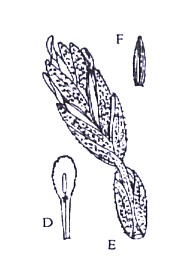
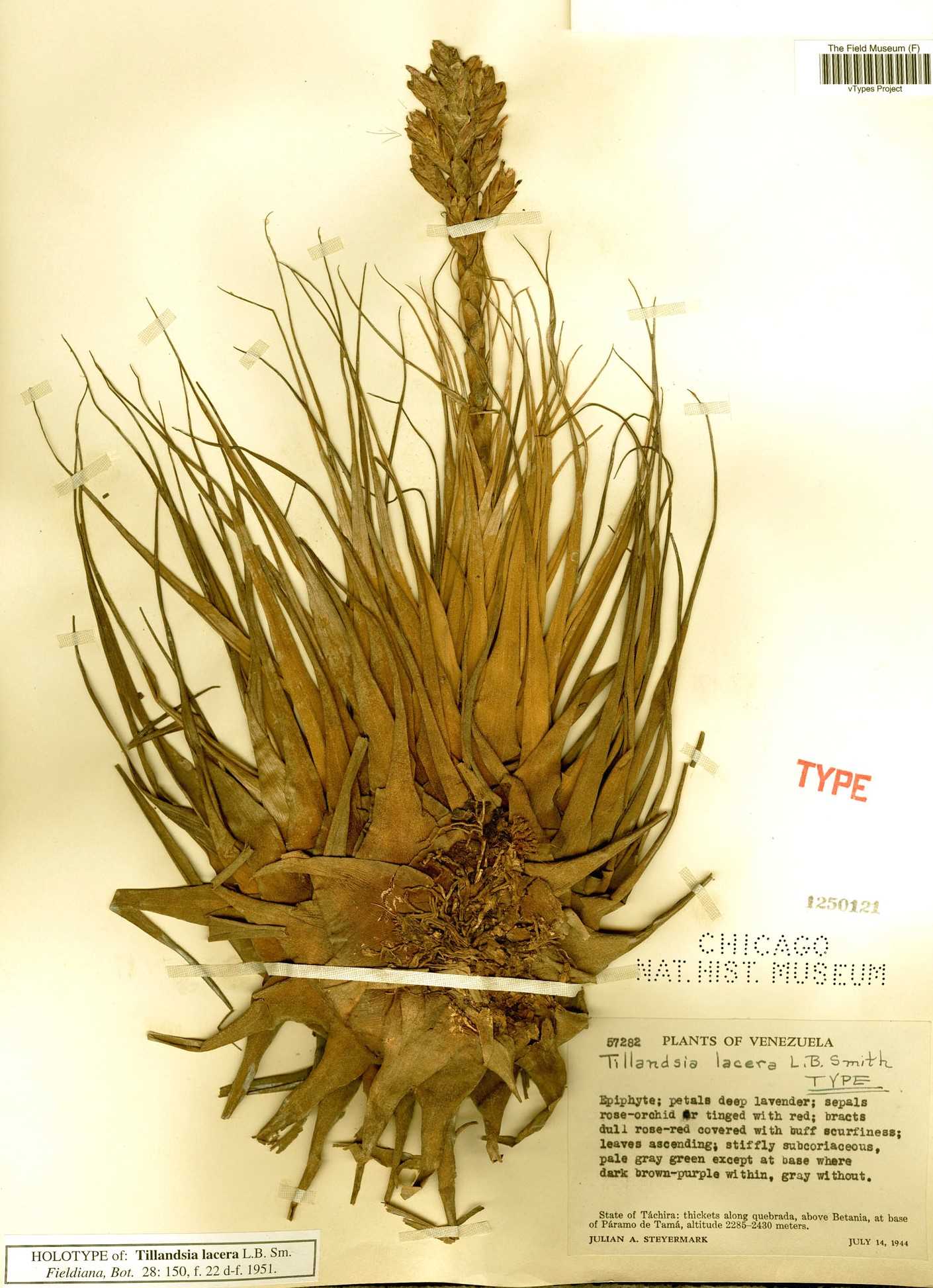

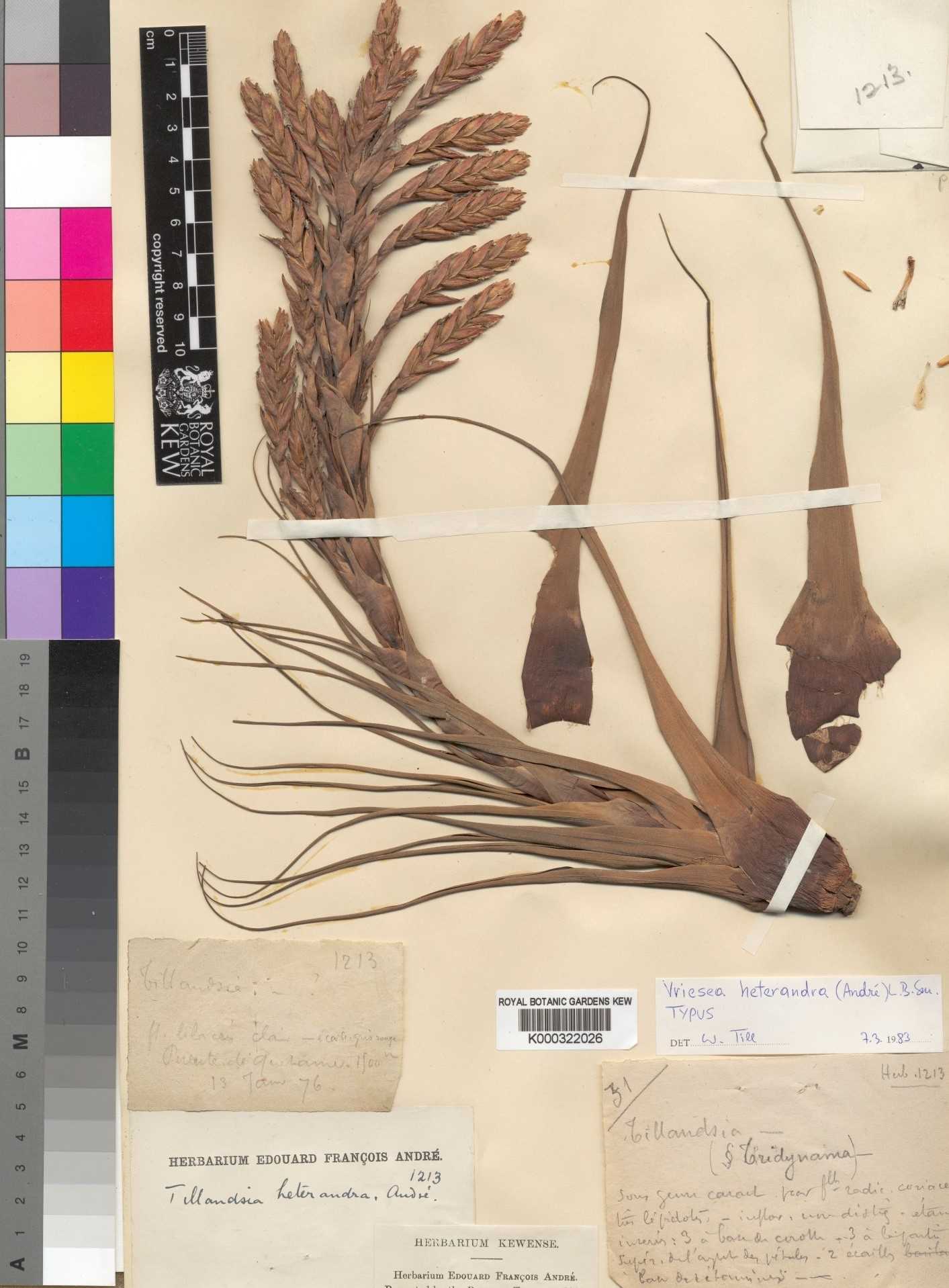
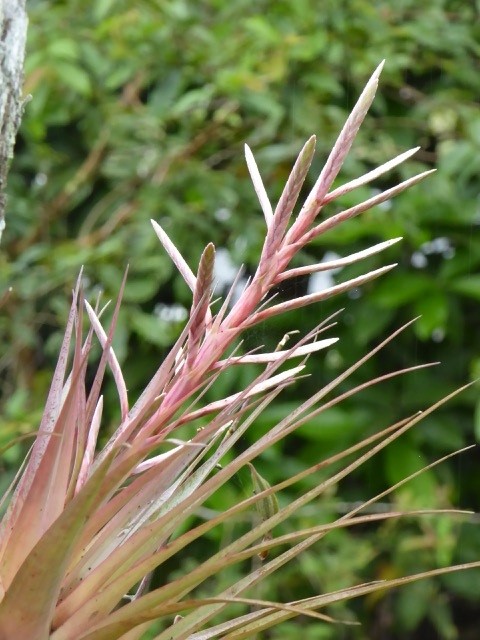
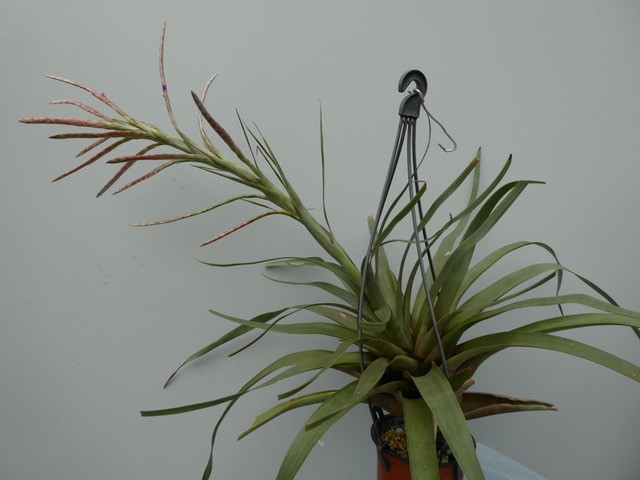
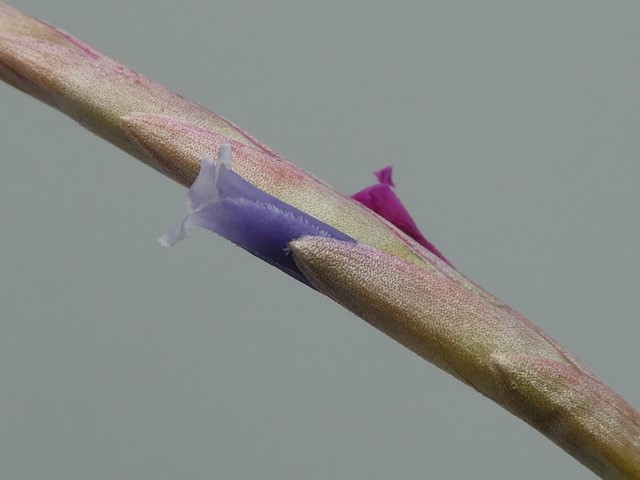
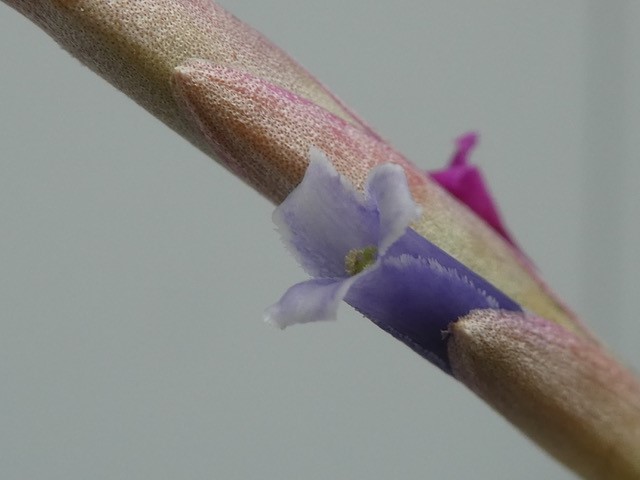
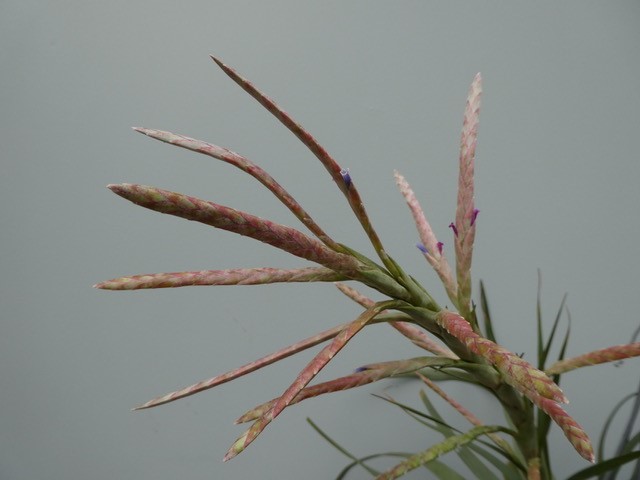
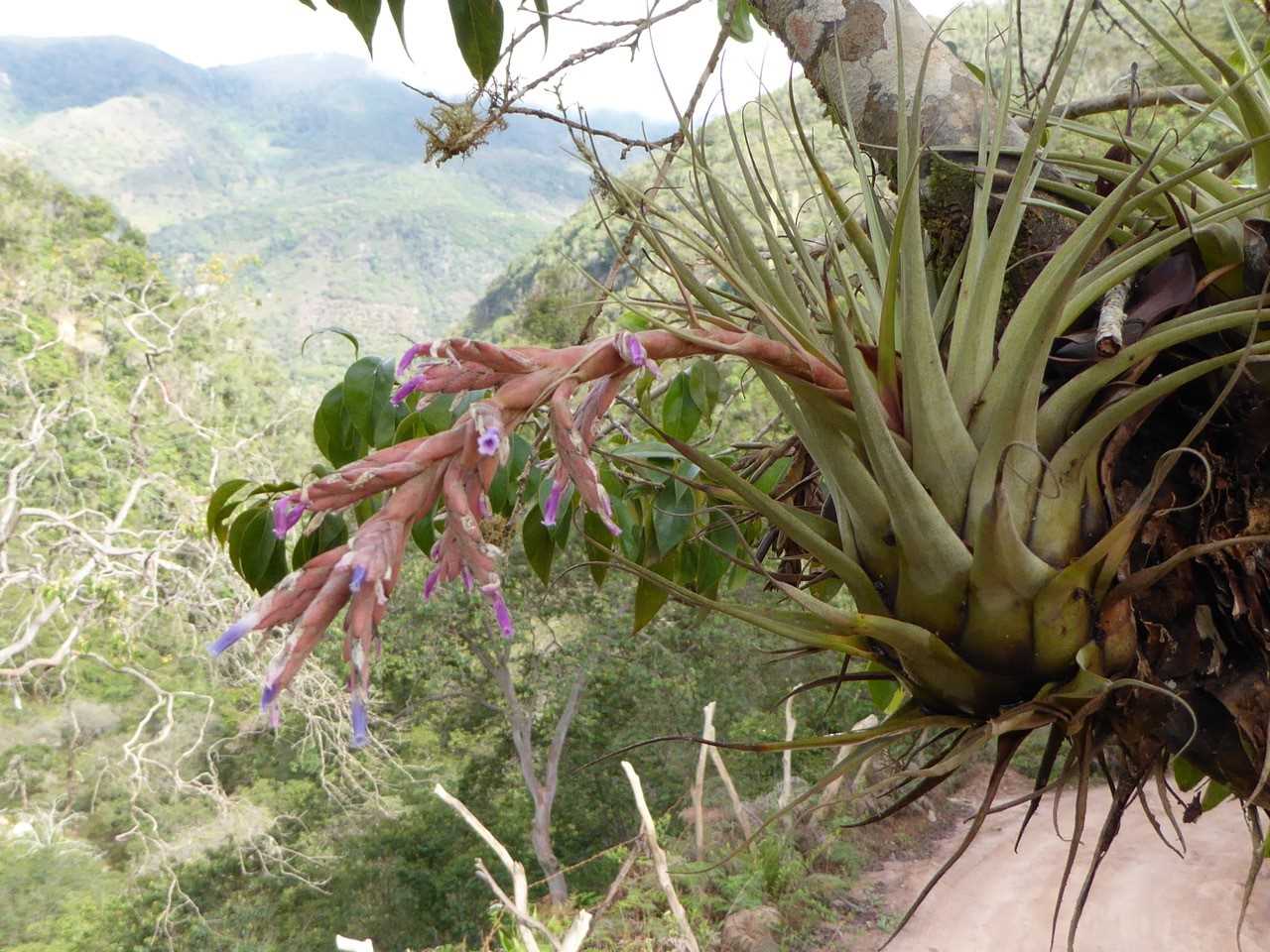
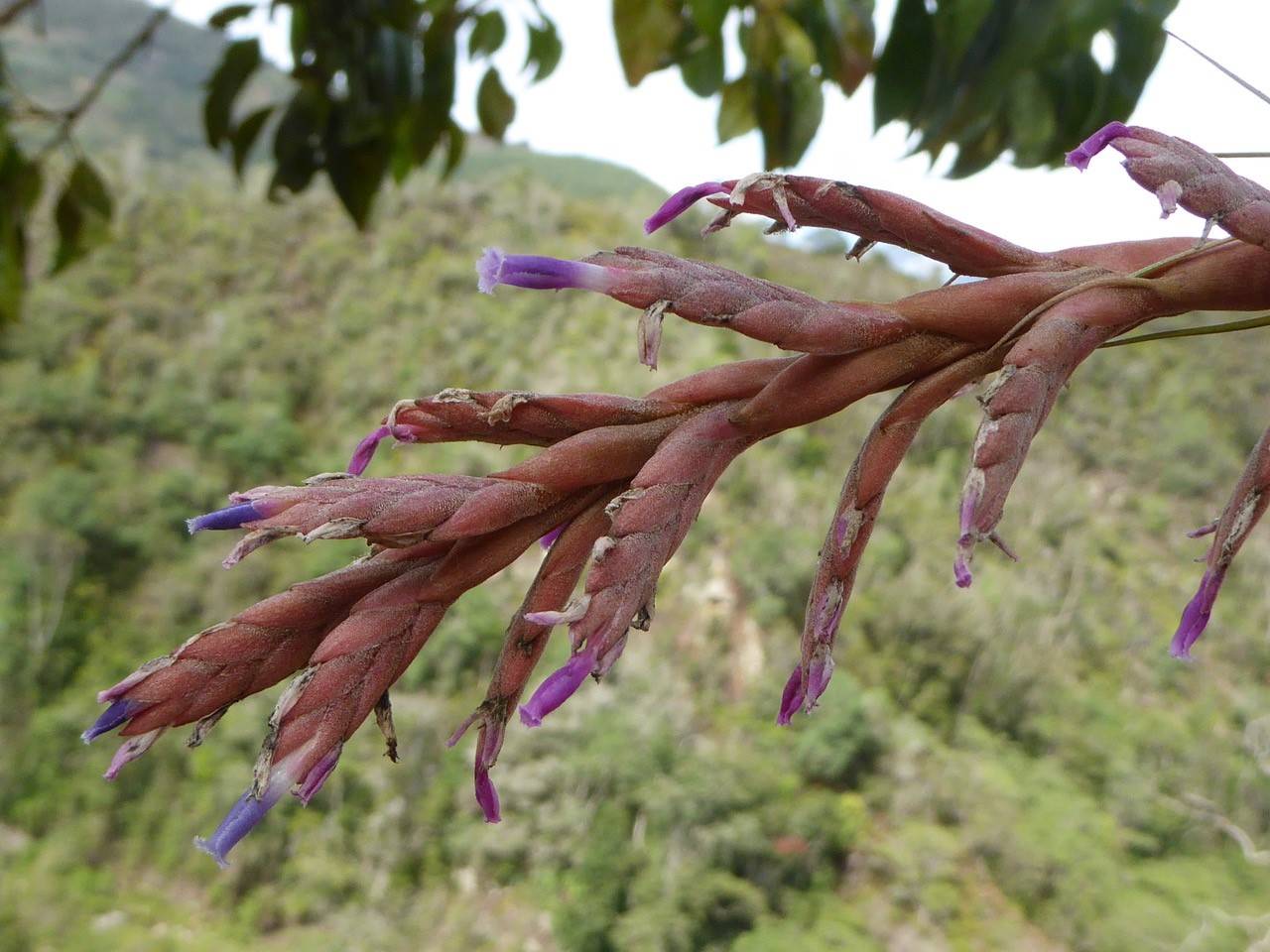
Desc from S&D
Plant stemless, to 35 cm high.
Leaves 3-4 dm long, covered with appressed cinereous brown-centered scales;
Sheaths very broadly ovate or elliptic, 6-10 cm long, dark castaneous;
Blades very narrowly triangular, 15-20 mm wide.
Scape curved or straight;
Scape bracts imbricate, ovate with long subsetaceous blades, densely lepidote.
Inflorescence bipinnate, 15-20 cm long;
Primary bracts erect, like the scape-bracts but the upper ones merely apiculate, about equaling the sterile bases of the spikes or shorter;
Spikes linear-lanceolate, acute, complanate, spreading and 4-7 cm long above the sterile base, dense.
Floral bracts ovate, acute, 13 mm long, exceeding the sepals, carinate toward apex, nerved, densely lepidote;
Flowers subsessile.
Sepals free, elliptic-oblong, acute, 10 mm long, ecarinate, glabrous;
Petals 18 mm long, pale rose, crenulate or lacerate, bearing 2 linear acuminate largely adnate scales;
Stamens included, the second series partially adnate to the petals.
Capsule slenderly cylindric, 2 cm long.
Type. Andre 1213 (holotype K, US photo), Puente de Quetame, Andes of Bogota, Cundinamarca, Colombia, Jan 1876.
DISTRIBUTION. Epiphytic in thickets and rainforest, 400-2300 m alt, Colombia to Venezuela and Bolivia.
COLOMBIA. GOAJIRA: Serrania de Macuira, 3 Dec 1953, Romero Castaneda 4487 (COL). MAGDALENA: Sierra de Perija, Manaure, 14 Nov 1959, Cuatrecasas & Romero Castaneda 25333 (US). NORTE DE SANTANDER. Bellavista, 15 Sep 1946, Foster 1695 (GH, US); Sarare, Oct 1941, Cuatrecasas, Schultes & Smith 12566 (GH). SANTANDER: California, jan 1927, Killip & Smith 17115 (GH). BOYACA: Bachira, Sierra Nevada del Cocuy, 20 Aug 1957, Grubb, Curry & Fernandez 614 (K, US). NARINO: Urcusique, 23 Nov 1946, Foster 2249 (COL, GH). VENEZUELA. ARAGUA: Parque Nacional Henry Pittier, 20 Oct 1961, Steyermark 89810 (US, VEN). TACHIRA: Paramo de Tama, May 1967, Steyermark & Dunsterville 98369 (VEN); 98707 (US, VEN). ECUADOR. LOJA: Chinche, San Pedro to Zaruma, 30 Jul 1939, Penland & Summers 1168 (GH). BOLIVIA. LA PAZ, Larecaja: Tipuani, 5 Aug 1929, Buchtien 7184 (US).
Tillandsia lacera L. B. Smith, Fieldiana Bot. 28: 150, fig. 22 d-f 1951.
Acaulis, florifera 27 cm, alta; foliis multis, dense rosulatis, erectis, 12-20 cm. longis, utrinque dense adpresseque lepidotis, vaginis late ovatis vel suborbicularibus, atro-castaneis, laminis anguste triangularibus, long acuminatis, 2-3 cm. latis, cinereolepidotis; scapo erecto, gracili; scapi vaginis dense imbricatis, ellipticis; dense lepidotis, infimis foliaceo-laminatis, alteris late rotundatis dein abrupte lineari-caudatis vel apiculatis, ex sicco chartaceis; inflorescencia dense bipinnatim paniculata, breviter cylindrica, 7 cm, longa, 3,5 cm. diametro; bracteis primariis eis supremis scapi similibus, erectis, bases steriles spicarum sub¬aequantibus, spicis e basi sterili nuda erecta divergentibus, dense 4-6-floris, oblongis, acutis, complanatis, 20 mm. longis, 8 mm. latis; bracteis florigeris dense imbricatis, lanceolatis, subcucullatis, 9 mm. longis, sepala paulo superantibus, obtuse carinatis, chartaceis, nervatis, dense adpresseque cinereo-lepidotis; floribus subsessilibus; sepalis liberis, lanceolatis, late acutis, 8 mm. longis, carinatis, nervatis, glabris; petalis 13 mm. longis, auriculis binis praeditis, laminis oblongis, late rotundatis, valde laceratis, fulgide lilacinis, stamina stylaque superantibus (Fig. 22, d-f).
Translated by Butcher
Plant stemless, flowering 27 cm high;
Leaves many, forming a dense rosette, erect, 12-20 cm. long, both sides dense adpressed lepidote,
Sheaths broad ovate or suborbicular, dark chestnut brown,
Blades narrow triangular, long acuminate, 2-3 cm. wide, grey lepidote;
Scape erect, slender;
Scape sheaths densely imbricate, elliptic; dense lepidote, lowest ones with leaf-like blades, otherwise broad rounded then abruptly linear caudate or apiculate, when dry chartaceous;
Inflorescence dense bipinnate panicle, short cylindric, 7 cm long, 3.5 cm. diam;
Primary bracts similar to the upper scape bracts, erect, subequal to the sterile bases of the spikes,
Spikes with a naked sterile base, erect spreading, dense 4-6-flwered, oblong, acute, complanate, 20 mm. long, 8 mm. wide;
Floral bracts dense imbricate, lanceolate, subcucullate, 9 mm. long, a little exceeding the sepals, obtuse carinate, chartaceous, nerved, dense adpressed grey lepidote;
Flowers subsessile;
Sepals free, lanceolate, broad acute, 8 mm. long, carinate, nerved, glabrous;
Petals 13 mm. long, with two auricles, blades oblong, broadly rounded, clearly lacerated, shiny lilac,
Stamens exceeding the style
(Fig. 22, d-f).
Type collected in thickets along quebrada, above Betania; at base of Paramo de Tama, state of Tachira, alt. 2285-2430 m., July 14, 1944, Julian A. Steyermark 57282.
On account of its lacerate auricled petals, Tillandsia lacera is obviously related to T. heterandra, but it differs in its abruptly caudate upper scape-bracts, denser inflorescence, and short spikes with naked sterile bases.